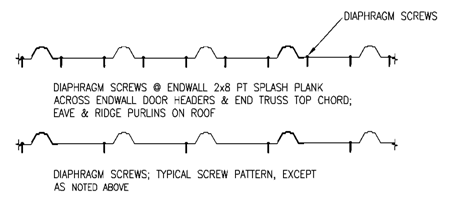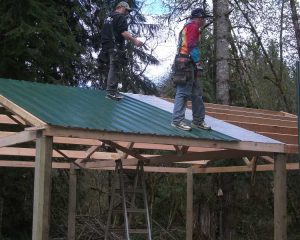Here is an excerpt from Chapter 16 of the Hansen Pole Buildings’ Construction Manual:
Use sheeting screws ONLY on one side of each high rib (See Figure 16-2) with the following exception:
- Roof – each high rib side at Eave Girt and Ridge Purlin (as well as at any end over end splices).
Figure 16-2
Use 1-1/2” long diaphragm screws at eave purlin and ridge purlin, installing one screw on EACH high rib side (unless instructions state otherwise).
If double screws are used at any other locations, there will NOT be enough screws.
Use a diaphragm screw next to each high rib (one side only) on field purlins. These will be 9” on center, with first screw next to overlap rib.
This language also appears on the blueprints for every Hansen Pole Building which has steel roofing or siding. As not everyone is a reader, a handy diagram is also provided so as to clarify any possible confusion.
Earlier this week, Hansen Pole Buildings’ Shipping Wizard Justine forwarded to me this message from one of our clients:
“This client thinks he is short screws for the roof, would you run a quick count. He feels he should have received 2618 screws for his building”.
As usual, I start with the premise of we must have done something wrong, so I did a complete breakdown by hand. This client’s particular building is a monitor style (https://www.hansenpolebuildings.com/building-styles/monitor-building-designs/).
Here was the breakdown I provided: Each wing has 8 rows of fasciae, eave girts & purlins
Main roof has 10 rows
(8 X 2) + 10 + 8 extra (to account for double screws at eave and ridge of four roof planes) = 34 X 51′ of roof = 1734 X 4/3 (4 screws per 3′ width panel) = 2312
At times I am realizing I am not sufficiently verbose in my answers, and I might confuse some clients, as I did this one who responded:
“I am unclear about what each of your numbers represent, it looks like this was calculated by linear foot per panel, but that would be incorrect.
Please run this by your tech support:
- Plans call for one screw at each raised rib on each purlin, with screws on both sides of each ridge at the eave and ridge. That makes 8 screws on each end (2×8=16), and 5 screws for each remaining purlin (5×6=30). That makes the total 46 for each sheet of steel. There are 34 sheets between the two wings. 34 sheets x 46 screws each = 1564 screws for the wings
- For the main roof that makes 8 screws on each end (2×8=16), and 5 screws for each remaining purlin (5×3=15). That makes the total 31 screw for each sheet of steel. There are 17 sheets on each side of the main roof, equaling 34 sheets x 31 screws each = 1054 screws for the main roof.
- 1564 + 1054 = 2618 total screws.
Thank you for sending the additional screws, but I do want to clarify both for myself and others, as their method for calculating does not appear to work for all roof designs.”
The client told me where he went wrong – It is FOUR screws for each remaining purlin (36″ width / 9″ o.c. ribs = 4). Somehow he is using (or planning on using) a fifth screw.
The instructions on the blueprints even go so far as to specify the field screws as having four per panel.
The Hansen Pole Buildings Instant Pricing™ system is not perfect, but is pretty darn accurate. Assembling one of our buildings and find something which isn’t adding up? Contact us before it is too late and additional materials are needed to resolve the issue.

 Today the fasteners of choice for corrugated roofing are gasketed hex-head screws with a metal and rubber washer below the head. As the screws are driven, the washer presses against the metal roofing to form a waterproof seal. If the screws are driven correctly, fastening through either the valleys or the ridges of the roofing is considered acceptable in this country. Valid arguments can be made for both preferences. If the fasteners on your roof were all properly driven, it is unlikely that they are the source of your leaks, regardless of whether they were driven through valleys or ridges.
Today the fasteners of choice for corrugated roofing are gasketed hex-head screws with a metal and rubber washer below the head. As the screws are driven, the washer presses against the metal roofing to form a waterproof seal. If the screws are driven correctly, fastening through either the valleys or the ridges of the roofing is considered acceptable in this country. Valid arguments can be made for both preferences. If the fasteners on your roof were all properly driven, it is unlikely that they are the source of your leaks, regardless of whether they were driven through valleys or ridges.





